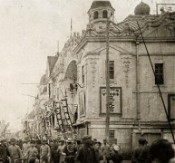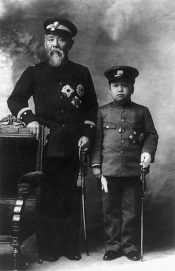1907
From 1907 to 1909 the number of movie theatres increased rapidly, a mixture of old vaudeville halls revamped into cinemas and the construction of new edifices more or less resembling Western style theatres. By 1909 more than 40 film theatres were operating in Tokyo, of which 30 had opened that year (Yoshida: 72-73, Ueda: 53). It is generally accepted that the second permanent film theatre built in the country was the Shinseikan, which opened its doors on April 1 in the neighborhood of Kanda, Tokyo. However, there is also evidence of a variety hall in Asakusa, Tokyo, that had held performances of female divers having been reconverted into a film theatre which reopened as the Bionkan in January (Ueda : 53). On April 16, the film production, exhibition and distribution company Yoshizawa Shoten inaugurated a new cinema in this same area, the Asakusa Sanyukan. Meanwhile, in Osaka the production company Yokota Shokai launched its own Denkikan movie theatre in the Sennichimae district to become the first one in the Keihanshin region, comprising the cities of Osaka, Kyoto and Kobe. Sennichimae would see another cinema, the Bunmeikan, opening on December 20. The most dramatic example of this shift in entertainment preferences took place in Asakusa's Rokku theatre district soon to become the country's movie-goer's Mecca. The misemono (sideshow) halls that had once lined the streets of the Rokku district were quickly replaced by theatres showing films from 1907 until the beginning of the Taisho period (1912-1926) (1).
As pointed out by Ueda Manabu many of these cinemas had in fact been operating as yose (variety hall) hosting all kind of misemono performances before they were remodeled into film theatres (see my article on the Asakusa Denkikan). Thus, the Asakusa Sanyukan had served as a bazaar prior to its conversion into a cinema while the Sennichimae Denkikan had been functioning as a yose, the Masae-za, and so had the Bunmeikan, known earlier as the Daini Izutsu (2). Even after their renovation into cinemas, most still continue to feature in their programs a variety of misemono shows, kineorama (an admixed form of diorama, film projections and electric light effects), and, most importantly, rensageki performances. The latter, in fact, fought with only-film performances for supremacy in the theatres until the mid 1910s.
The following year more cinemas opened in Tokyo (in Asakusa the Fukujukan, April, the Taishokan and the Fujikan, July. In Kagurazaka the Bunmeikan, May. In Ushigome, now Shinjuku, the Bunmeikan, May. For a period of time this cinema was also called the first Bunmeikan or Daiichi Bunmeikan (Yoshida: 64). In Honjo the Taihekan, June. In Asabu, now Minato, the second Bunmeikan or Daini Bunmeikan, September) and Osaka (the Naniwa-za in Dotonbori, January, in Sennichimae the Daini Sekaikan, September, and the Nihonkan, November) as well as other major cities such as Nagoya (the Bunmeikan in Osu Kannon, January, and the Chuo Denkikan in Hirokoji, April)and Kyoto (the Shinkyogoku Denkikan, February, run by the Yokota Shokai). Meanwhile, according to the Yokohama Archives of History, in December 1908 the first film theatre in Yokohama opens in the Nigiwai district, the M Pathe Denkikan, known as the Shikishimakan from 1909 (3). However, other sources argued instead that the first cinema was the Kinemakan in the Fukutomi district, owned by Uchiyama Umekichi, and which opened in May 1908 (4). It was remodelled and converted into a two-storied Western style theatre renamed as the Denkikan, also known as the Kanko Kinen Denkikan, in September the following the year. This might explain the change of name of the cinema run by the M Pathe Company.
- At the end of the Meiji period there two famous troupes of acrobats balancing on rolling balls in Asakusa; the Aoki's Tamanori troupe and the Egawa's Tamanori troupe. While the Aoki's troupe disbanded and the Daiichi Kyoseikan hall, which had opened in the 1880s, where they had held their acrobatic shows turned into the Asakusa Taishokan cinema in July 1908, the Egawa's troupe continued to perform at their misemono koya (hall) Seiyukan (known as the Taiseikan from 1901) until 1923 (Yoshimi : 211-12). Before its conversion into the Taishokan, the Daiichi Kyoseikan's acrobatics on balls programme held in the afternoon was complemented by an evening exhibition of moving pictures. Also, according to Irie Yoshiro's study of extant stills from some of the earliest films shot in Japan, there is evidence that one of these films, of which only 8 frames survives, featured the Egawa's troupe (Irie : 73).
- The Fujikan that opened on 13 July 1908 in Asakusa, Tokyo, had been called the Chin Sekaikan, while the Daiichi Kyoseikan, also in Asakusa, became the Taishokan starting business on the same day that the Fujikan.
- Ogasawara Mikio proposes the date of its opening as 1 January 1908, reopening as the Shikishimakan on 11 June 1908 (28).
- Yokohama Rekishi to Bunka - Kaiko 150 Shunen Kinen is among one of the publications that claim that the M Pathe Denkikan was the first cinema in Yokohama (264), while others such as Yokohama-shi o Aruku (172) and Yokohama Kindaishi Sogo Nenpyo (321) argued that it was the Kinemakan. Before its conversion into the Kanko Kinen Denkikan film theatre, the Kinemakan is described as a kasetsu koya or temporary playhouse (Yokohama-shi Chuo Toshokan Kinenshi Henshu Iinkai hen: 41), which could account for this discrepancy.
Sources:
Irie, Yoshiro Saiko no Nihon Eiga ni Tsuite - Konishi Honten Seisaku no Katsudoshashin (The Earliest Japanese Movie �\ Motion Pictures Produced by Konishi Honten), MOMAT Research, 2009, Vol 13, pp.65-91.
Iwao, Akune, Ganso, tamanori kyokugei oichiza : Asakusa no misemono, Tokyo: Arina Shobo, 1994.
Kaneko, Atsuko, Ongaku Bunka to Engeki in Shinshu Nagoya-shi Shi; Meiji, Volume 5, Edited by Shiozawa Kimio and Kondo Tetsuo, 2000, pp 838-848.
Matsunobu, Tasuke, Ishii, Mitsutaro, Tokairin, Shizuo (editors), Yokohama Kindaishi Sogo Nenpyo, Yurindo, 1989.
Murou, Saiseki, Chindon Sekai, in Modan Toshi Bunkaku: Toshi no Shuen edited by Unno Hiroshi, Kawamoto Saburo) and Suzuki Sadami, March 1993, pp 289-297.
Nornes, Abe Mark and Gerow, Aaron (editors), Eigagaku no Susume: Makino Mamoru ni Sasageru / In Praise of Film Studies: Essays in Honor of Mamoru Makino, Yokohama: Kinema Club, 2001.
Oda, Sadao, Yokohama-shi o Aruku, Nihon Hoso Shuppan Kyokai, 1977.
Ogasawara, Mikio , Shinbun Shosetsu no Gekika ni Tsuite, in Shotokushu Yokohama no Shibai to Gekijo Yokohama Kaiko Shiryokan Kiyo, Dai 10 Go, 1992, pp 26-33.
Takamura, Naosuke and Yokohama-shi Furusato Rekishi Zaidan (editors), Yokohama Rekishi to Bunka: Kaiko 150 Shunen Kinen, Yurindo, 2009.
Tanaka, Junichiro, Nihon Eiga Hattatsushi: Katsudo Shashin Jidai, Chuo Koronsha, 1980.
Ueda Manabu, Eiga Josetsukan no Shutsugen: 1900-nendai no Denkikan to Sono Kankyaku Kara / The Emergence and Transformation of the Moving Picture Theaters: An Analysis of the Denkikan theater and the Cinema Audience in the 1900s, Art Research, 9, 2009, 49-59.
Yokohama-shi Chuo Toshokan Kinenshi Henshu Iinkai hen, Yokohama no hon to bunka : Yokohama-shi Chuo Toshokan kinenshi, Yokohama-shi : Yokohama-shi Chuo Toshokan, 1994.
Yokohama-shi Kowankyoku Kikakuka and Yokohamako Shi Kanko Inkai, Yokohama-ko Shi Dai 2 Kan, Yokohama Koshinko Kyokai, 1989.
Yohohama Kaiko Shiryokan / Yokohama Archives of History, Shiryo Yomoyama Hanashi 2: Yokohama ni Eigankan Nakkata Koro.
Yohohama Kaiko Shiryokan / Yokohama Archives of History, Shiryo Yomoyama Hanashi 2: Gekieiga no Kokai.
Yoshida, Chieo, Mo Hitotsu no Eiga-shi: Benshi no Jidai, Tokyo: Jiji Tsushinsha, 1978.
Yoshimi, Shunya, Toshi no Doramaturugi: Tokyo sakariba no Shakaishi, Kawade Shobo Shinsha, 2008.

(1907-1944)

